The GoPro Wing Mount: Elevate Your Kiteboarding Experience
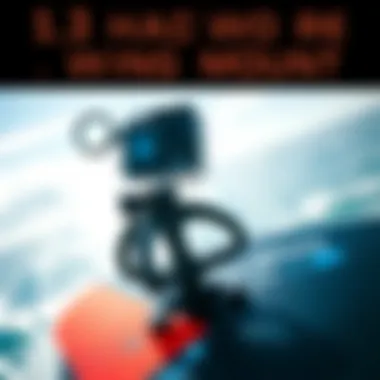
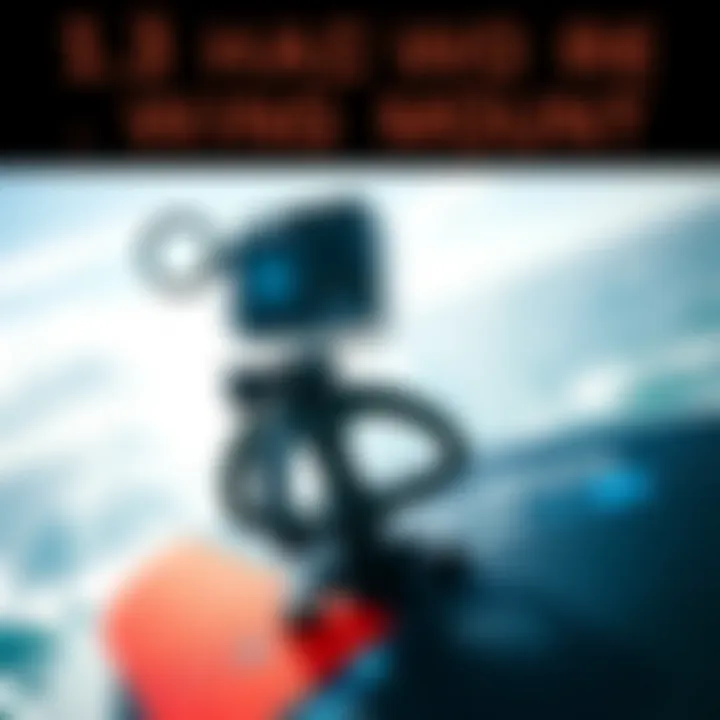
Intro
Kiteboarding is a thrilling fusion of wind and water, where the harmony of aerial maneuvers meets the challenge of ocean waves. To truly capture this adrenaline-pumping sport, kiteboarders are turning to innovative technology—specifically, the GoPro wing mount. This versatile accessory provides a unique perspective, making every trick and wave a visual masterpiece. This article serves as a comprehensive guide for those eager to enhance their kiteboarding experiences with this exceptional gear.
Diving into the significance of a GoPro wing mount, we will explore its advantages, installation techniques, and how it revolutionizes the way kiteboarders tell their stories through stunning footage. Also, we'll discuss various types of wing mounts, essential accessories that complement the experience, and tips to optimize video quality. As safety cannot be overlooked in extreme sports, we’ll address important considerations and maintenance routines that ensure the longevity of both the gear and the rider's safety. Ultimately, this discussion aims to equip novices and seasoned kiteboarders alike with all the necessary insight to enjoy the wind on their faces with a camera securely mounted on their wings.
Gear Selection
When it comes to kiteboarding, choosing the right gear is as crucial as mastering the techniques in the sport. The right kite and board can dramatically impact performance and enjoyment. In this segment, we'll break down the key aspects of gear selection, focusing on kites and boards, ensuring every kiteboarder finds their ideal setup.
Types of Kites
Kites for kiteboarding come in various shapes and sizes, each designed for different conditions and skill levels. Here’s a rundown of the most common types:
- C-shaped kites: These are great for big air and performance tricks. They have a distinct curved shape that helps generate powerful lift.
- Bow kites: These kites are user-friendly and excellent for beginners. They provide stability and have a wide wind range, making them suitable for varying conditions.
- Foil kites: Known for their efficiency and lightweight design, foil kites are a popular choice among experienced kiteboarders who prioritize speed.
Choosing the right kite depends on your skill level, the type of riding you prefer, and the conditions in which you will be riding. The greater the understanding of the variations, the better the outcome on the water.
Choosing the Right Board
The board plays a pivotal role in the overall kiteboarding experience. Here’s what to consider when selecting the board:
- Board Size: The size of the board can drastically affect how you ride. Larger boards provide better float and stability, especially for beginners.
- Board Shape: Different shapes (such as directional boards or twin-tips) influence maneuverability and riding style. Twin-tips are versatile, allowing for both regular and goofy stances, whereas directional boards are often favored for surf-style riding.
- Flexibility: Boards offer different flex ratings, impacting how they perform under different conditions. Stiffer boards are usually better for aggressive riding, while softer boards provide a more forgiving experience.
In short, knowing your riding style and conditions is essential when selecting the right board. Putting the time into research pays off significantly, resulting in a tailored kiteboarding experience that enhances every session.
Skill Development
Once you've selected the appropriate gear, the next step is skill development. It’s not just about having the best products; practice and techniques shape a kiteboarder's ability.
Essential Techniques
Fundamental skills like body positioning, steering with the kite, and maintaining balance on the board are crucial. Documenting each session using the GoPro can help identify areas needing improvement. Here are some essential techniques for mastering kiteboarding:
- Body Positioning: Keep your weight centered over the board. Lean back slightly when the kite is low, using your body weight to edge effectively.
- Steering with the Kite: Learning how to control the kite in the wind window is vital. Finding the sweet spot to maximize lift while maintaining control is an art.
- Water Starts: This foundational skill allows you to transition from the water to riding smoothly. Practicing this helps build confidence and gets you on the board quicker.
Progression Tips
Every kiteboarder wishes to progress their skills steadily. Here are a few tips:
- Set Achievable Goals: Instead of trying to land a complex trick on the first try, break it into small, manageable steps. Celebrate small victories; they add up!
- Analyze Your Footage: Use footage from the GoPro to analyze your form and technique. You can see what works and what doesn't, offering insight that may not be visible in real-time.
- Find a Community: Riding with others not only makes the experience more enjoyable but also provides opportunities to learn from peers and instructors.
By fostering skills and confidence, kiteboarders can enjoy exhilarating sessions while continually refining their techniques.
"Investing in the right gear and focusing on skill development allows kiteboarders to maximize their experiences on the water."
This article will continue to explore how integrating the GoPro wing mount with kiteboarding gear and skill development can elevate one's experience to new heights.
Prolusion to the GoPro Wing Mount
Kiteboarding, with its adrenaline-pumping maneuvers and breathtaking scenery, begs for a method to capture its essence. Enter the GoPro wing mount, a little device that transforms your regular kiteboarding session into a cinematic adventure. This mount is not merely about affixing a camera to your gear; it’s about preserving memories, showcasing skills, and sharing the thrill of riding the waves.
The utility of a GoPro wing mount cannot be overstated. It allows riders to capture their sequences in motion, presenting a vivid narrative of their journey across the water. In a world where content is king, the ability to document standout moments provides both personal satisfaction and social currency. As kiteboarders glide through the air, spin into tricks, and crash into waves, the footage gathered is not just entertainment—it's a vivid representation of an ever-evolving sport.
Before delving into the finer details of installation or types of mounts, it’s important to understand why the GoPro wing mount has become integral for shooters and riders alike. The design is aimed at maintaining stability, and it securely holds the camera at an optimal angle, allowing for dynamic footage without constant adjustments. This means that the camera can effortlessly keep up with a rider’s orientation, focusing on the action rather than being a hindrance.
However, this mount also brings with it considerations that need to be acknowledged. Factors such as the mounting location on the kite or board can influence the quality and perspective of the footage, making each choice critical in the editing room. It’s also essential to consider the ambient conditions and potential risks associated with capturing video in the thrilling, yet sometimes unpredictable, environment of kiteboarding.
In summary, the GoPro wing mount serves as a bridge between the thrill of kiteboarding and the art of storytelling through video. It empowers the rider by enhancing their capability to share experiences and reflects the beauty inherent in the sport. Like a skilled artist chooses their brush, the kiteboarder selects this mount to ensure their adventures are documented with clarity and flair.
Understanding the Purpose
The GoPro wing mount fundamentally reshapes how kiteboarders capture and share their exhilarating experiences on the water. Its unique design provides an advantage not only for recording thrilling action but for engaging others through authentic storytelling. Understanding the purpose behind these mounts dives deeper than the technology itself; it's about enhancing the kiteboarding experience.
Capturing Action
When you strap a GoPro wing mount onto your equipment, you're not just affixing a camera; you're opening the door to immersive storytelling. Imagine gliding over the waves with a wind gust that sends your board flying, and your GoPro captures each moment – every twist, turn, and leap. The beauty of using a wing mount lies precisely in this ability to capture dynamic footage hands-free, allowing riders to focus on the wind and water, instead of fiddling with equipment.
The role of the mount goes beyond mere convenience; it serves as a canvas for adventure. The action footage you gather showcases the raw energy of kiteboarding, often drawing viewers right into the heart of the sport. The role of angle can’t be understated either. A well-positioned GoPro can showcase not just the rider, but the breathtaking scenery and waves. This perspective changes everything, turning a good video into an unforgettable one.
Sharing Experiences
In today’s digital landscape, sharing experiences takes on a new meaning. Capturing the thrill of kiteboarding isn't just about the ride; it's about connecting with a broader community. The GoPro wing mount enables enthusiasts to share their journeys with friends, family, and fellow kiteboarders worldwide. From social media reels to specialized kiteboarding forums, your footage reaches far beyond personal archives.
Each shared video tells a story; it’s a personal experience blended with the joy of kiteboarding. This makes it significant. It invites others into your world, allowing them to feel the rush of excitement through your lens. By sharing quality footage, kiteboarders inspire one another, encourage new learners, and contribute to the collective passion for the sport. The GoPro wing mounts serve as a bridge, connecting individuals and experiences, showing just how exhilarating kiteboarding can be. When one person shares joy, it echoes throughout the community, encouraging even more to pick up that board and ride.
"Footage captured with a GoPro wing mount doesn’t merely reflect a ride—it projects a passion that resonates with fellow adventurers."
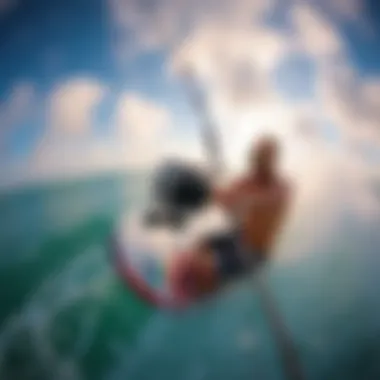
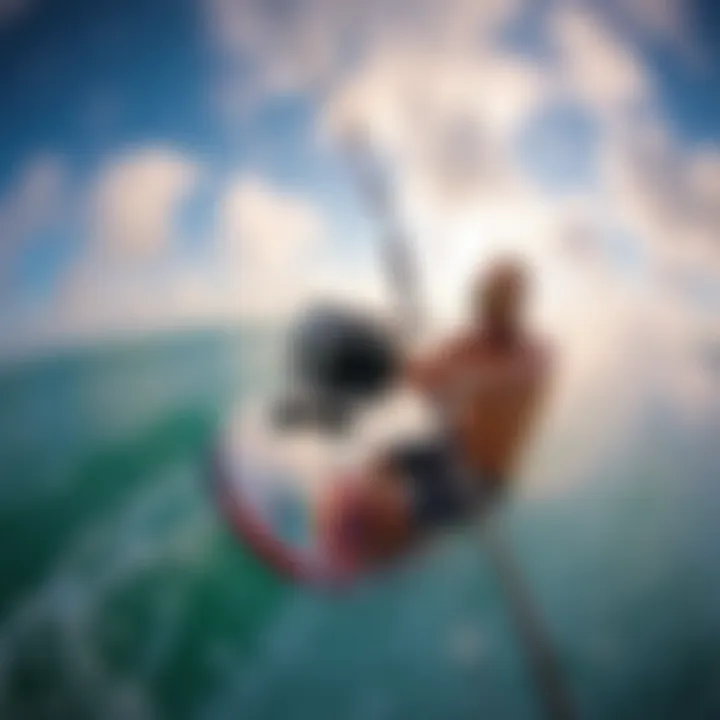
In short, understanding the purpose of the GoPro wing mount consolidates its significance in kiteboarding. It is more than just a gadget – it’s a vital component that enhances adventure, feeds excitement, and fosters community connection.
Types of GoPro Wing Mounts Available
In the realm of kiteboarding, where the wind whips and waves dance, the choice of a GoPro wing mount can significantly enhance the adventure. Different types of mounts cater to specific needs and preferences, offering kiteboarders the ability to capture their thrilling rides from unique perspectives. Let's delve into the distinct options available and understand their value in shaping the kiteboarding experience.
Standard Mounts
Standard mounts serve as the baseline for capturing action-packed moments. Made to be reliable and easy to use, these mounts typically feature a straightforward design, allowing quick attachment to your kite's wing or board. One of their most attractive benefits is their affordability, making them accessible for both beginners and seasoned riders alike.
The simplicity in mounting also ensures that the setup can be completed swiftly, so you can hit the water without delay. However, there are considerations to keep in mind.
- Limitation in Angles: Standard mounts usually allow for fixed angles, which means you might miss out on some dynamic shots
- Durability Concerns: Depending on the brand, the quality of plastic or material used can affect longevity.
Using a standard mount demands a bit of creativity when it comes to framing the shot, but it can yield impressive footage if approached with care.
Adjustable Mounts
Now, adjustable mounts step things up a notch. They come with mechanisms that allow you to tilt, rotate, or reposition your camera to capture those exhilarating moments from different angles. If you’ve ever watched footage where the rider gives a stylish spin, often, an adjustable mount was key to that captivating shot.
The key advantages include:
- Versatile Positioning: You can tweak the angle while out on the water if you're feeling adventurous.
- Enhanced Creativity: Different angles lead to varied perspectives that add depth to your storytelling.
On the flip side, having a steeper learning curve is common:
- Increased Setup Time: Getting the angle just right can take time, especially for new users.
- Potential for Movement: If not secured properly, adjustable mounts might shift during intense maneuvers, leading to awkward footage.
Craftsmanship matters here; investing in quality brands can mitigate some of these risks and enhance the overall filming experience.
Specialized Mounts for Kiteboarding
Specialized mounts designed specifically for kiteboarding offer the top tier of functionality and adaptability. These mounts typically feature rugged designs and advanced securing systems to withstand the unique challenges of the sport.
For kiteboarders who want to highlight their movements and the relationship with the wind and water, these mounts are crucial. Among the notable features:
- Streamlined Design: Many come with wind resistance in mind, minimizing drag during your ride.
- Multi-Position Options: Some models allow for front and rear mounting, giving options for capturing your kite as well as your dynamic riding style.
However, while they offer numerous advantages, they typically come at a higher price point. To sum up:
- Pricey Investment: Premium design and materials mean spending a bit more; however, the payoff in footage quality can be significant.
- Overkill for Enthusiasts: If you’re just dipping your toes into kiteboarding, such advanced features might be excessive.
Ultimately, as you explore the various types of GoPro wing mounts, consider your filming style, the intensity of your ride, and how you plan to share your exhilarating experiences. Investing in the right type can elevate not only your filming abilities but also the storytelling nature of your adventures on the water.
Installation Techniques
When it comes to using a GoPro wing mount for kiteboarding, installation techniques play a pivotal role in ensuring the effectiveness of your footage. The way you set up your camera not only affects the quality of your shots but also contributes to your overall safety while riding the waves. Thus, knowing how to properly install your mount can lead to breathtaking captures, without compromising your ability to enjoy the thrill of kiteboarding.
Choosing the Right Location
Selecting the right location for your mount is critical. You want to showcase your movements and the beautiful backdrop of the water while keeping your gear secure.
- Consider the Angle: Think about how you're going to use the camera. Some kiteboarders prefer a front-facing setup to highlight their jumps, while others may want a side angle to capture their maneuvers. Each location provides a unique perspective.
- Outside of Jibing Path: Avoid placing the mount where it can be hit by the kite or lines. Ideally, it should be away from the areas that might interfere with your riding.
- Attach to Stable Surfaces: The mount should be secured to a stable part of your gear, often the mast or the front edge of your board, ensuring it won't wobble or jostle during heavy winds.
Securing the Mount
Securing the mount is as much about the physical attachment as it is about peace of mind. A mount that isn't secured properly can lead to disaster and lost footage.
- Use Proper Hardware: Always make sure you utilize the screws and brackets that come with your mount. Quality hardware can make a world of difference in terms of reliability.
- Check for Loose Fixtures: Before heading out, double-check all fixtures to see if anything is loose. It's a good practice to occasionally check these during your session, especially if you’re going for some extreme tricks.
- Test Adhesives: If you're working with adhesive mounts, allow proper cure time before hitting the water. Checking the adhesion strength by tugging gently can avoid nasty surprises mid-ride.
Verifying Stability
Verifying stability is a step often overlooked but crucial. A shaky camera means shaky footage, which can ruin an otherwise perfect shot.
- Pre-Ride Test: Before filming your kiteboarding adventure, do a quick stability check. Stand on your board and wiggle it a bit. Ensure the mount remains firmly attached and doesn’t sway unnaturally.
- Conduct a GoPro Test: Do a short radius turn while filming to see how the camera reacts. If it shakes or rattles, you need to reassess the mounting position.
- Watch for Vignetting: Sometimes a well-secured mount might still end up causing visual distortions like vignetting in your footage due to poor camera position. Adjust, if necessary, to capture sharp images.
Optimizing Video Footage
In kiteboarding, where moments unfold in the blink of an eye, optimizing video footage becomes an indispensable part of capturing the thrill and beauty of the adventure. Anyone who has ever watched a poorly shot video will agree that clarity, stability, and proper composition can make or break the experience. Not only does great footage enhance your storytelling, but it also cements those memories for future enjoyment.
Camera Settings
Having the right camera settings is crucial for achieving high-quality footage with your GoPro wing mount. Here are some essential settings to consider:
- Resolution: Depending on your GoPro model, opting for 4K resolution can provide stunning detail, especially when capturing vibrant kite colors and energetic movements. However, if you’re prioritizing frame rate for smoother footage, consider lowering it to 1080p.
- Frame Rate: A higher frame rate, such as 60fps or even 120fps, allows for smooth motion, especially during fast maneuvers. Yet if you plan to capture slow-motion clips, shooting at a higher frame rate, then playing back at a lower rate can enrich the viewing experience.
- Field of View: The GoPro allows you to choose between Wide, Medium, and Narrow views. Wide is often preferred in action sports for dynamic shots, capturing as much of the environment as possible.
These settings are the tools you’ll wield in crafting your visual narrative. Take some time prior to your session to experiment with various combinations to see what highlights your individual style best.
Framing the Shot
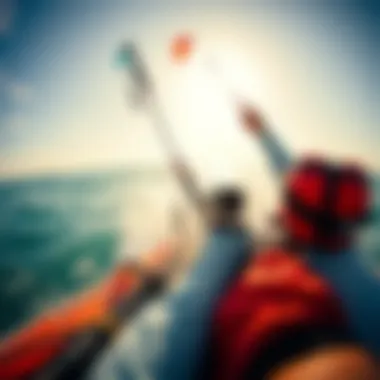
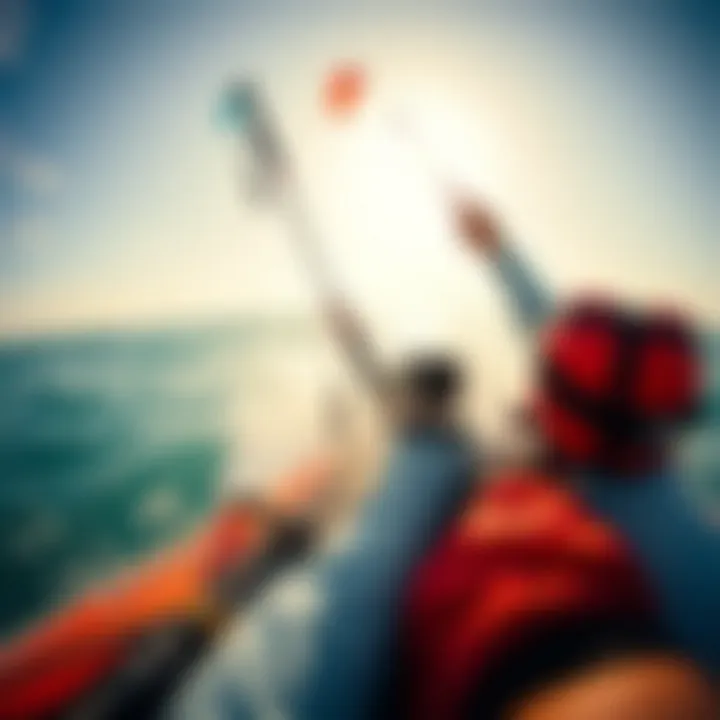
Once your settings are dialed in, framing your shots is the next critical step. A well-composed shot can turn a simple action into a compelling visual story. Consider the following strategies:
- Rule of Thirds: Imagine your frame is divided into three equal horizontal and vertical sections. Position the key elements of your scene along these lines or their intersections. For instance, placing your kite on one of the vertical lines can create an aesthetically pleasing balance.
- Dynamic Angles: Change up your angles to capture the action from various perspectives. A low-angle shot can make jumps appear more epic, while an aerial view showcases the beauty of the surrounding waters. Don’t hesitate to vary your framing throughout your session, as it keeps the footage lively.
- Focus on Movement: Kiteboarding is about movement. Try to anticipate the action, framing your shots where the action is likely to occur, rather than just recording what’s directly in front of you.
These framing techniques will help you encapsulate the essence of your kiteboarding experience, inviting viewers to feel the rush of the wind and water.
Post-Production Tips
After capturing your footage, the editing phase can elevate your raw clips into a polished piece of art. Here are a few tips to consider:
- Stabilization: Most editing software offers stabilization features. This can smooth out shaky footage, enhancing the viewing experience without requiring the most perfect conditions during shooting.
- Slow Motion Highlights: By utilizing slow-motion effects on high frame rate shots, you emphasize crucial moments, such as a well-executed trick or splashdown. This can make your footage feel more dramatic and engaging.
- Color Correction: Kiteboarding often occurs under various lighting conditions, which can impact how colors appear in your footage. Correcting colors in post-production can bring back the vibrancy that may have dulled during filming.
- Create a Narrative: Think about how you want to tell the story. Organize your clips to create a flow, perhaps starting with serene shots of the setting before building into more action-packed sequences.
Editing is where you can truly express your creativity and bring your kiteboarding adventure to life.
Remember, every setup is unique. Experimentation is key.
By focusing on optimizing your video footage with the correct settings, thoughtful framing, and careful post-production, you will not only enhance your own experience but also share your passion with others through high-quality content.
Safety Considerations
When engaging in kiteboarding, balancing thrill with safety is paramount. The use of a GoPro wing mount opens up a world of opportunity, but it also introduces a new layer of responsibility. Understanding the potential hazards tied to mounting techniques, environmental conditions, and overall equipment integrity can mean the difference between a memorable adventure and a dangerous mishap.
Mounting Risks
The process of securely installing a GoPro wing mount is one that should not be rushed. A poorly attached camera can detach during exhilarating maneuvers, posing risks not only to the kiteboarder but also to others in proximity.
Here are a few things to keep in mind:
- Check Compatibility: Not every mount fits every board or wing type. Ensure you have the correct equipment, or you might be setting yourself up for failure.
- Use Quality Fasteners: Cheap or worn-out hardware can compromise the mounting’s stability. Invest in robust fasteners designed for marine conditions.
- Regular Checks: Frequent evaluations of the mount after spins and jumps will help catch any wear and avoid unexpected losses mid-flight.
"Regular inspections of your mount could save your camera and create a safer riding experience."
Weather Effects
Unpredictable weather conditions can influence the safe use of a GoPro wing mount. Wind speeds, humidity, and sudden weather changes can affect both your kiteboarding performance and the camera’s stability. Rising winds can make it easier for a loosely attached mount to dislodge, and rain can hamper visibility and damage electronics.
- Pay Attention to Forecasts: Before heading out, check meteorological updates. If conditions appear unfriendly, it might be wise to postpone your session.
- Adjust Mount Positioning: If windy or rainy weather is expected, be cautious about where you place your GoPro mount. Some angles are more prone to wind interference than others.
Equipment Failure Prevention
To avoid an equipment failure that could derail your adrenaline-fueled day, proactivity is key. Take a few moments before every session to verify the functionality of all gear, including the GoPro mount.
Here are some fundamental practices to help ensure a smooth kiting experience:
- Inspect All Components: Look over the camera, battery, and mount before going out. Check for any signs of wear, cracks, or loose parts.
- Utilize a Safety Leash: In case of a dislodgment, a safety leash can prevent your camera from plummeting into the water, where recovery can become a tedious task.
- Adhere to Guidelines: Follow the manufacturer's instructions for both the GoPro and the mount. Knowing the limits and capabilities of each piece of gear helps prevent misuse.
Safety in kiteboarding isn’t just about wearing harnesses and life vests. It extends to the gear you use and how well you maintain it. Taking the time to consider these factors not only protects your equipment but enhances the overall experience.
Maintenance of GoPro Wing Mounts
Proper upkeep of GoPro wing mounts plays a crucial role in extending their lifespan and ensuring your kiteboarding adventures are captured with optimal clarity. These mounts face various challenges, from erratic weather conditions to the inevitable wear and tear of frequent use. By making maintenance a priority, you can prevent mishaps that could lead to compromised video quality or even damaging the mount itself.
Regular inspections and consistent care strategies are not just about aesthetics; they also enhance performance and longevity. With a bit of diligence and attention to detail, you can ensure that your GoPro wing mount remains reliable throughout your kiteboarding escapades.
Regular Inspections
Regular inspections of your GoPro wing mount are akin to checking your gear before hitting the waves. Just like a captain thoroughly inspects a boat before sailing, kiteboarders must keep an eye on their mounts. Simple visual checks can go a long way. Look out for signs of wear, such as:
- Cracks or fatigue in the mounting materials
- Rust or corrosion on metal components
- Loose screws or fittings that may have come undone
Looking deeper than the surface is equally important. If the mount has been subjected to rough treatment, examining the attachment point on the kite is essential. A poorly fitted mount can lead to video instability or worse—an unexpected loss during a big trick. Developing a routine to examine your gear pre- and post-session ensures you're not caught unprepared.
Regular maintenance isn’t just a task; it’s peace of mind for every kiteboarding adventure.
Cleaning and Care
Cleaning your GoPro wing mount is part and parcel of responsible ownership, especially in the unpredictable realm of kiteboarding. Saltwater, sand, and mud all have the potential to degrade your mount if not cleaned properly. Here’s how you can maintain your mount in top condition:
- Rinse Thoroughly: After each use, especially in saltwater, rinse the mount with fresh water to wash away any residue that may cause corrosion.
- Use Mild Soap: For tougher grime, a mild soap solution can help break down dirt without damaging the surfaces. Avoid harsh chemicals that could erode the materials.
- Dry Completely: Ensure that the mount is dried thoroughly after rinsing. Leaving any dampness can encourage rust, particularly on metal parts.
- Inspect for Build-Up: Pay attention to joints and crevices where dirt may accumulate. Using a soft brush can help remove debris without scratching.
- Store Properly: When not in use, store the mount in a cool, dry place to prevent exposure to extreme temperatures and humidity, which may affect its structure.
Investing some time in maintenance practices translates to better performance and an extended lifespan for your GoPro wing mount. After all, the clearer the footage, the richer the story you'll be able to share.
Embedding the Mount Train into Your Practice
In the world of kiteboarding, consistently capturing outstanding footage hinges on your comfort and familiarity with the GoPro wing mount. Embedding the mount within your practice routines enhances not just filming technique but overall kiteboarding skill. The significance of this practice can hardly be overstated; when it becomes second nature to attach and adjust your gear, you free yourself to focus on the ride itself.
Routine Use
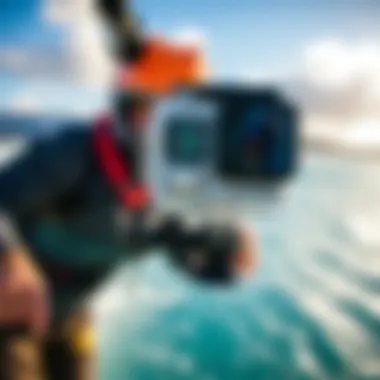
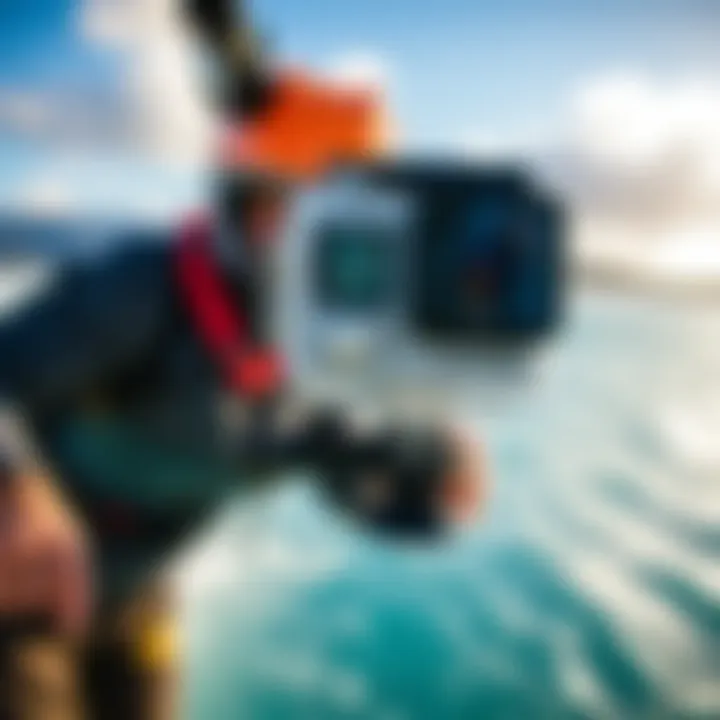
Integrating the GoPro wing mount into your daily kiteboarding sessions facilitates muscle memory and allows for a more intuitive filming experience. Beginning with the basics, every time you gear up, make a conscious effort to mount your camera. Whether it’s a breezy afternoon or during a calm sunset session, practice securing the mount effectively across various conditions. This regular exposure familiarizes you with placements and angles that provide the best footag.
- Check your mounting points regularly: Skim through your regular routines to identify where the mount lands better.
- Clarity in movements: As you pull maneuver after maneuver, keeping the mount routine might even adjust your own riding posture. It encourages you to pay attention to your technique, ultimately leading to better performance.
Experimentation with Angles
Once the GoPro becomes an integral part of your sessions, the door opens to experimenting with angles that can make your footage pop. Not just sticking to static shots, changing perspectives while kiteboarding can amplify the narrative of your experience. Whether capturing a clean jump or a sweeping turn,
the angles you decide to shoot from define the visual story you want to tell.
Here are a few approaches that can enhance your creativity:
- Lower Angles: Positioning the camera closer to the water gives a unique feel of speed and motion.
- Above Head Shots: Helps in showcasing the entire kite setup and your body posture while riding.
- Side and Rear View Perspectives: Provides insight into your ride and can help highlight the gorgeous backdrop.
Experimenting doesn’t need to happen only when you’re on the water. Grab your setup on land too, tweak the mount, test it out, and steer clear of the unneeded clicks later on.
Embedding the GoPro mount in your kiteboarding practice isn’t merely about documenting one’s journey; it’s more about evolving your understanding of the sport through visual storytelling. With each session, the habit becomes less cumbersome and more natural, and soon you’ll find the fusion of your kiteboarding and film-making experiences enriching one another, giving you not just a record of your adventures but a well-crafted narrative of your journey on the waves.
Community Feedback on GoPro Wing Mounts
Community feedback plays a significant role in shaping the understanding and use of GoPro wing mounts among kiteboarders. Insights shared by users and experts alike provide a wealth of information regarding the practical aspects of these mounts. Feedback includes everything from first-hand experiences to expert reviews that can illuminate what to expect from GoPro mounts in kiteboarding scenarios. This section will delve into both user experiences and expert opinions, equipping readers with a rounded perspective.
User Experiences
The voices of everyday kiteboarders resonate with unique experiences that contribute meaningfully to the discourse around GoPro wing mounts. Many users emphasize the thrill of capturing every airborne trick or wave slam with ease. One kiteboarder, Sarah, shared her adventure of trying to film her jumps. "Mounting the GoPro on my wing not only gave me stunning angles, it also allowed me to share the exhilaration with my friends who couldn't be there," she noted.
Such sentiments echo across various forums and review platforms. Common themes include the ease of mounting and the stability of the footage during rigorous kiteboarding sessions.
Nevertheless, it is not all smooth sailing. Some users mention challenges with orientation. For instance, a user named John cautioned, "If you don’t get the angle just right, you might end up with a lot of sky or water — not exactly the highlight reel looked for." This serves as a reminder that while these mounts offer exciting opportunities, some trial and error in positioning can lead to the best results.
"Capturing the perfect moment can require a handful of tweaks to get it just right!" — John, a devoted kiteboarder.
Adjustable mounts are frequently praised for their flexibility. Users have shared that these mounts make a world of difference when it comes to varying conditions on the water. Whether riding an erratic wind pattern or adjusting to an unusual wave height, customizing the position can be indispensable.
Overall, user feedback showcases the practical, real-world applications of GoPro wing mounts, demonstrating that kiteboarders are often eager to share their experiences to both inform newcomers and fine-tune their own skills. This sharing culture can foster a stronger community of kiteboarding enthusiasts who learn not just from their successes, but also from their missteps.
Expert Opinions
Expert insights provide a different lens through which to view the role of GoPro wing mounts in kiteboarding. These professionals have an eye for detail and can discern the utility based on security, stability, and usability of the mounts. Renowned kiteboarding instructor, Mark, emphasizes, "When mounted correctly, GoPro should feel like an extension of your kite, capturing every exhilarating moment without distraction."
Experts advise on the importance of conducting regular assessments of the mounts prior to sessions. Many professionals recommend thorough checks of all fixtures and fittings to ensure everything is secure. They often mention that the way equipment is maintained can dramatically affect performance, which is something casual users might overlook.
Additionally, experienced videographers offer their take on optimization strategies. For example, they advise kiteboarders to try various mounting positions to find what captures the best angles for their unique style. "What works for one person may not work for another," expert videographer Lisa says.
As kiteboarding grows more popular, input from experts helps refine equipment use further. Their insights can often lead to innovations or adaptations of existing products — all in the name of enhancing the kiteboarding experience.
Expert opinions contribute depth to the article, illustrating that a balance of hands-on user experiences and professional insights is crucial in understanding the full impact that GoPro wing mounts can have on kiteboarding adventures. This combined feedback informs and enhances the practices of both novice and seasoned kiteboarders.
Future Developments in Camera Mounting Technology
As technology hurtles forward, the landscape of camera mounting systems is evolving at a breakneck pace. This is particularly vital for kiteboarding, where the right equipment can mean the difference between a remarkable capture and a missed opportunity. The future promises innovations that not only enhance the filming experience but also address limitations in current mounts, improving stability, usability, and integration with new devices.
Innovative Features
Anticipated innovative features in upcoming camera mounts include improved stabilization technology, which is essential in the high-motion world of kiteboarding. Battery-life enhancements are also on the horizon, promising longer shooting times without the need for frequent replacements. Such advancements could include flexible batteries that mold with the mount better, keeping equipment lighter and less cumbersome right around your kiteboarding setup.
Another exciting development is the integration of AI capabilities. With smart mounts, users may be able to set specific filming scenarios, allowing cameras to automatically adjust angles and settings based on real-time conditions. For instance, capturing a magnificent jump might trigger the camera to zoom in or stabilize on the boarder.
Improvements in material technology play a role as well. Lighter and sturdier composites promise to provide mounts that can withstand the salty sea and the high-velocity winds without sacrificing reliability. This might even extend to buoyant mounts, which could remain afloat if they take an unexpected dive into the water, making retrieval much easier.
Impact on Kiteboarding Filmmaking
The integration of future camera mounting technologies holds immense potential for kiteboarding filmmaking. Enhanced stabilization systems will enable smoother footage, reducing shaky images that can detract from the thrill of the experience. Filmmakers can focus on their creativity, crafting more cinematic tales without getting bogged down by technical limitations.
Moreover, these innovations can foster a deeper connection between the audience and the sport. With better footage quality, spectators will feel as though they’re on the water, riding the waves alongside the kiteboarders. This immersive quality can aid in community growth, attracting new participants to the sport while simultaneously engaging seasoned veterans eager for an enhanced visual experience.
Furthermore, the anticipated improvements in accessibility and integration with smartphones or drones could revolutionize how content is created and shared. Sharing captivating kiteboarding moments via social media will become an effortless task, which can significantly influence brand partnerships and event promotions.
In essence, as these innovative features begin hitting the shelves, they will empower not just kitesurfers but also filmmakers—redefining the way visual stories of the ocean's thrill are told. With this progress, kiteboarding presents itself not just as a sport, but as a canvas painted by enthusiasts, instructors, and fans alike.
"The next generation of camera mounts could turn every kiteboarding session into a cinematic masterpiece."
The fusion of technology and creativity is on the brink of an exciting transformation. For kiteboarders and videographers, keeping an eye on these advancements will be essential as they shape the future of storytelling in this dynamic sport.
Concluding Thoughts
In wrapping up our exploration of the GoPro wing mount's role in kiteboarding, it's important to recognize the profound impact this piece of equipment can have on enhancing one's experience on the water. Utilizing a GoPro wing mount opens up a world of possibilities for both storytelling and skill development. By capturing those thrilling moments—from a breathtaking jump to graceful glides over the waves—it allows kiteboarders to not only document their adventures but to also share them with a wider audience.
Key Takeaways
Consider the following elements as you reflect on this discussion:
- Versatile Mounting Options: Know that the variety available—from standard options to specialized mounts—affords users flexibility in choosing a setup that complements their individual riding style.
- Effective Installation: Getting the installation right can make all the difference. As highlighted in previous sections, location and stability are crucial elements that cannot be overlooked. A securely fastened mount can prevent mishaps and injuries while optimizing the camera angles.
- Footage Quality: It's vital to understand how camera settings and shot framing play a role in the storytelling aspect. Good footage not only tells a story but also showcases one's skills in a way that's compelling and visually striking.
- Safety First: The conversation on safety considerations bears repeating. Understanding the risks associated with mounting hardware and weather conditions is essential. Proper maintenance and pre-use checks are a must to safeguard both the equipment and the user.
- Community Insights: Engaging with fellow kiteboarders, whether through user experiences or expert opinions, offers valuable perspectives and tips that can enhance your own kiteboarding and filming experiences. Leveraging these insights can also foster a sense of community.
Looking Ahead
Ultimately, the GoPro wing mount serves as a bridge between adventure and art, allowing kiteboarders to document their journey in a way that resonates with others. As technology continues to evolve, we may see even more innovative solutions to enhance the relationship between the rider and their experiences on the water. Keeping abreast of these changes will enable kiteboarders to adapt and improve their storytelling techniques.
Thus, as you gear up for your next kiteboarding adventure, consider how this mount can alter your perception of the ride, foster creativity, and connect you with a community of fellow enthusiasts. Every flight through the skies can become a beautifully captured memory, waiting to be shared and celebrated.















